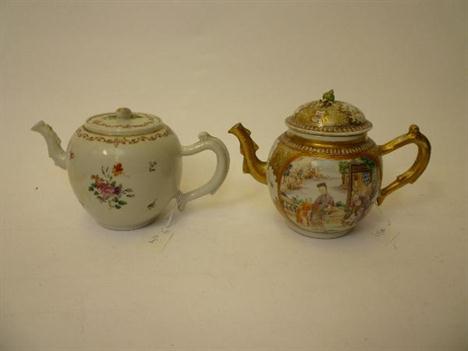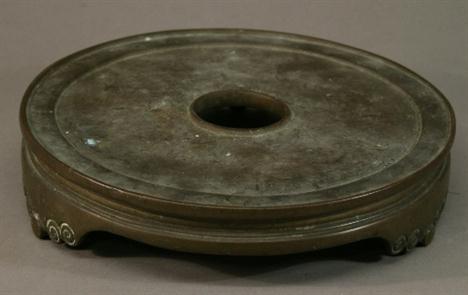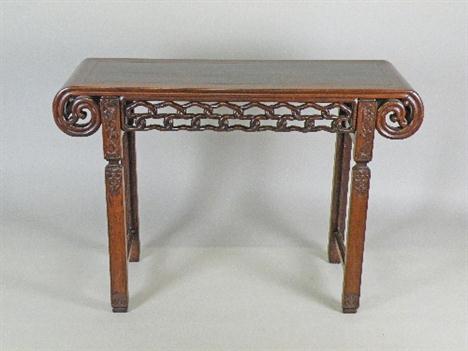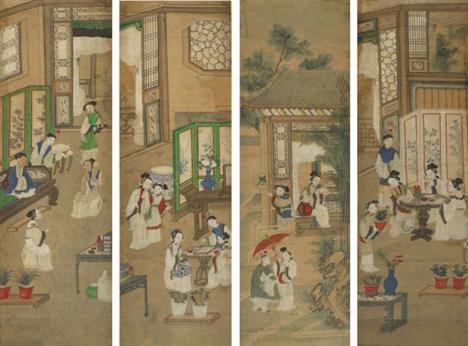TWO CHINESE EXPORT PORCELAIN TEAPOTS AND COVERS, 18th century, each of globular form with crabstock handle and spout, both painted in polychrome enamels, one with panels enclosing figures on verandahs, on a richly gilt scroll ground, the other with scattered flower sprays and sprigs, 5 3/4" x 5" high
We found 17386 price guide item(s) matching your search
There are 17386 lots that match your search criteria. Subscribe now to get instant access to the full price guide service.
Click here to subscribe- List
- Grid
-
17386 item(s)/page
A Chinese Scroll Painting, early/mid 20th century, depicting Chinese dragons, animals and figures, possibly by different hands, bears one seal 288x26.5cm, in a wooden scroll box: A Chinese Scroll Painting, depicting a mountain scene with figure standing on a bridge, bears three seals, 121.5x36.5cm: A Chinese Scroll Painting, depicting birds in a pink blossoming tree, 110x39cm, in a wooden scroll box, (3 scrolls)
A Chinese Scroll Picture, 20th century, depicting a seated sage, bears seal, 91x32 cm, boxed with script on lid: An Chinese Scroll Picture, 20th century, depicting a flowering branch by the moon, 107x41cm: A Chinese Scroll Picture, 19th/20th century, depicting temples in a mountain landscape, bears two seals, 27x17.3 cm., boxed, (scrolls), (3)
Follower of Fan Zeng, Chinese Contemporary School b.1938, a pair of calligraphic scroll pictures, one bears two seals, 97x31cm ea: together with three further Chinese scroll pictures, one depicting birds on a flowering branch, bearing two seals, 98x53cm., a bird on bamboo, bearing one seal, 85x52.5cm and a bird on a branch, bearing one seal, 138x21.5cm, all followers of Bai Xueshi b.1915, Zhao Shaowng, and Chen Peigiu 1922-2008, (5) (scrolls)
A Chinese Scroll Picture, 19th/20th century, depicting a bird amongst foliage, one seal, ivory jiku scroll ends, 32.5x58cm: A Chinese Scroll Picture, early 20th century, depicting a traveller crossing a bridge in a winter mountain landscape, 116x33cm, (a/f): A Chinese Silkwork Scroll Picture, 20th century, depicting two pigeons and a flowering branch, 64x32cm: A Chinese Scroll Picture, late 20th century, depicting two warriors on horse back in river, one seal, 37.5x49.5cm: A Chinese Ancestor Scroll Painting, 19th century, depicting a female dignitary in red robe with green edging, (a/f): An Oriental Scroll Painting on Silk, early 20th century, depicting a portrait of a European woman in black dress with pearls and locket, 51x34.5cm: together with a wooden box for a scroll, together with four other scroll paintings, (11) (scrolls)
A Republican period Chinese porcelain ovoid baluster vase, painted with two reserves, each with a scene of a dog in a landscape, the flared neck with reserves of flowering branch and bamboo decoration, the body painted with intricate stylized foliage and flower heads and the neck with two pierced gilded scroll handles, the base with blue seal, Qianlong seal mark, 43cm high.
A Chinese monochrome powder blue vase, 20th century, the baluster body relief moulded with three clawed dragons amongst clouds within ruyi strap work and cloud borders, thunder scroll and plantain leaf shoulder, apocryphal underglaze blue Yongzheng six character mark and stamped `China` in red, 25.5cm high
A Chinese hardwood three fold room screen circa 1920, now in two parts, the four panels decorated in relief with polished hardstone studies of ducks and lotus plants, birds perched amongst peony flowers, ho ho bird and cherry blossom and a bird in the branches of chrysanthemum within carved flower head and thunder scroll borders, the reverse of each screen with intaglio shaped cartouches of women and children, some chips and losses throughout, each panel 46cm wide, 175cm high
A Pair of Chinese Blue and White Export Porcelain Jars, circa 1790, each of plain cylindrical form, deeply grooved string rim, each painted with an extensive lakeland scene, 10.5cm high; and A Chinese Blue and White Export Soft Paste Porcelain Two-Handled Pedestal Cup, moulded in relief with butterflies and painted with reserves of lakeland landscapes, S scroll handles, circular foot, 10cm high (3)
A Pair of Chinese Porcelain Vases and Covers, Kangxi (1662-1722), of ogee section baluster form with mythical beast knops, painted in famille verte enamels with a band of precious objects above a red foliate scroll band over panels of birds amongst foliage and rockwork, on a dotted green and yellow foliate ground, 30.5cm high
A Chinese Porcelain Hexagonal Baluster Jar, Yuan, painted in underglaze blue with a broad band of scrolling lotus with scroll and lappet borders, 7.5cm high; and A Chinese Porcelain Baluster Jar, painted in underglaze blue with the IHS symbol within a sun burst circular cartouche, 12cm high (2)
A good Chinese bronze incense burner, probably 18th century. Crisply cast with animal mask handles and a central band of mythical beasts including dragons and winged horses, the rim and foot with stylized scroll work, the base with a four character mark Yu Tang Shi Sou (Jade Hall Stone Old Man), the body with a warm brown patina, 28.5cm. This rare mark including the characters for Shi Sou is more commonly found on figures.
A Chinese blanc de Chine figure of Guanyin, c.1700. Well modelled and seated wearing flowing robes and holding a ruyi sceptre and with a scroll box at her side on a rocky outcrop, the reverse with an impressed seal mark of Ho Ch’un Ch’ao, minor damage, 13.5cm. Paper label for John Sparks Ltd.
A Rare Chinese Cloisonne Revolving Vase. Qing dynasty, 2nd half 18th century, 36.5cm overall. Cast in three sections with a cylindrical water receptacle joining at the neck. The ovoid body has four gilded openwork panels each with a dragon and phoenix amidst abundant peony and scrollwork set against a turquoise ground decorated with a formal stylized lotus scroll. The rim and shoulder have scalloped rims, the foot, a champleve band of lappets. The internal section is also decorated with stylized lotus, but against a white ground. Drilled at the base and with damage to the rim, 31cm. A later wood stand (4) Provenance: A Scottish private collection, purchased in the 1950s. Catalogue note: Cf. The Complete Collection of Treasures of the Palace Museum, vol.43, p.169, no.161. for a related example; and also, Chinese Cloisonne, The Clague Collection, p.126, pl.58 for a closely related pair of revolving vases, see also the Freer Gallery of Art, Ichina, pl.102. and A.J. Koop, Bronzes and Cloisonne Enamel in Chinese Art, pl.XIX.
An Extremely Rare Chinese Imperial Gilded Spinach-Green Jade Buddhist Lion Dog. Qing dynasty, Qianlong period 1736-95, 20cm. Boldly carved from a massive spinach-green boulder, crouching with his head turned to the left and baring his teeth to reveal a slightly upturned tongue. The face with large eyes above a ruyi-shaped nose, tilts upwards; the angular chin is fringed with a short curling beard. His floppy scroll-like ears fall either side of the head and are divided by four rows of a tightly scrolling mane. The form of his body is accentuated by the pronounced, well-defined spine from which his flame-like coat falls. The mane, hair and scrolling tail are all finely incised and heightened in gold. The underside reveals four crisp claws beneath each paw. Provenance: The Bruce Collection, the 3rd Baron Alington of Crichel (1896-1940), the Hon. Mrs Mary Anna Marten OBE (1929-2010), Crichel House, Dorset.Exhibited: The International Exhibition of Chinese Art, The Royal Academy of Arts, London, 1935/6, catalogue no.2821. Illustrated: S C Nott, Chinese Jade Throughout the Ages, Pl.LXIII. Catalogue note: The lion was first introduced into China from India, following the arrival of Buddhism, and is not represented in jade carvings earlier than the Han Dynasty. The lion is the king of beasts and is associated with high rank and military power. Most Buddhist temples in China have two lion dogs, carved in stone or cast in bronze or iron as guardian figures at the entrances. These figures are either depicted with both front legs on the ground, or with one foot raised on a ball and puppy; whereas with most jade examples, the lion is crouching, cf. J C S Lin, The Immortal Stone, Chinese jades from the Neolithic period to the twentieth century, p.52. Chinese lions resemble Pekingese dogs, and are known as ‘Lion Dogs’, and are often portrayed with brocade balls. According to tradition, Buddha was born ten times as a lion, six as an elephant and once as a hare.
-
17386 item(s)/page



























































